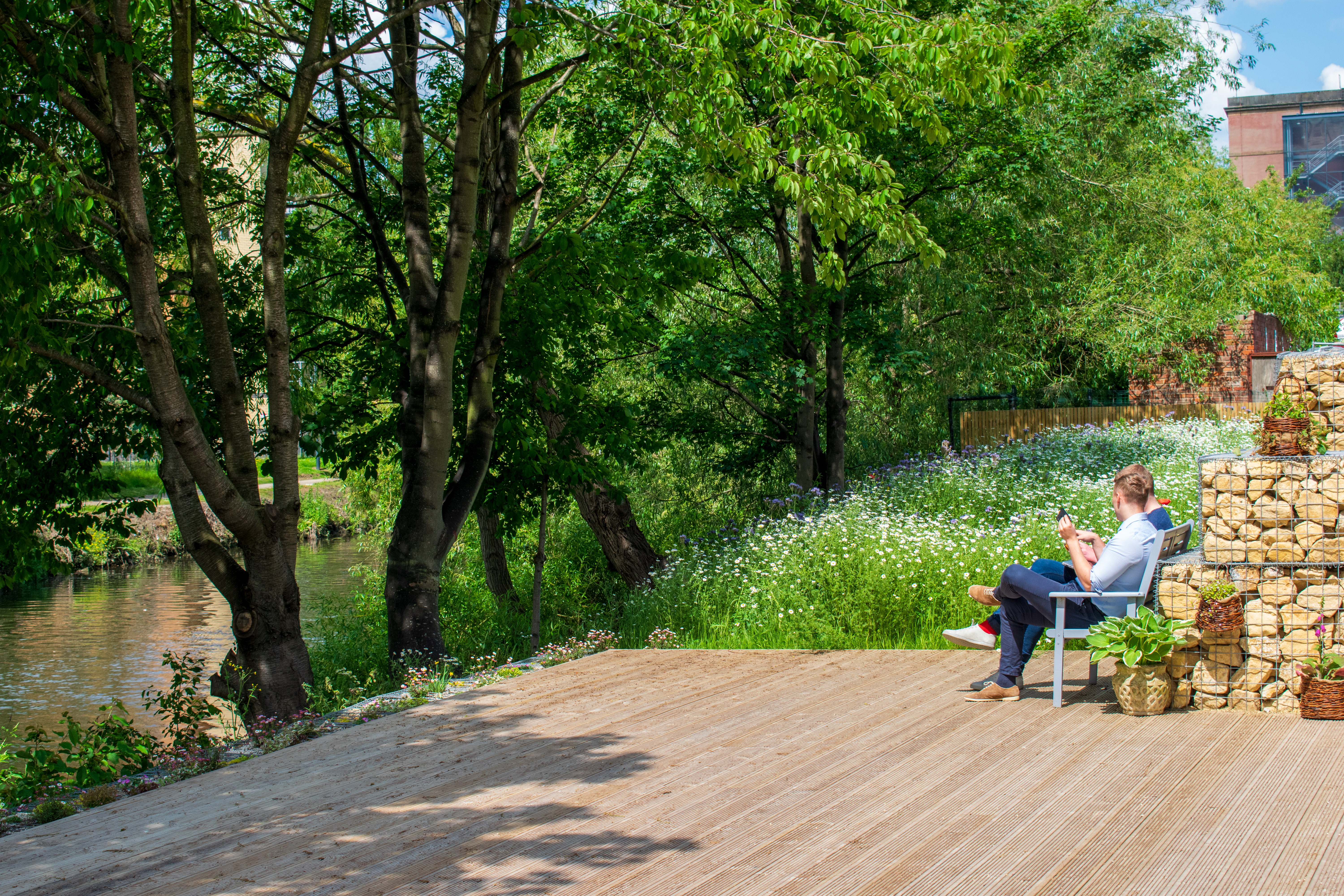Project showcase
Climate Innovation District

The Climate Innovation District represents a pioneering new approach to delivering sustainable places in the UK. The district spans both banks of the River Aire in the east of Leeds city centre and will comprise family houses, apartments, office spaces, retail spaces, a primary school, a small care home, and a community café. The district is designed to reduce carbon emissions at every stage. Buildings are timber- framed, manufactured In Citu’s onsite factory, to reduce embodied carbon. Passivhaus principles have been used to create homes with excellent insulation, triple glazed windows and MVHR systems that require over ten times less heating than an average UK home. The place is designed to encourage the transition to zero- carbon transport. The whole development is raised by several meters to create a car-free landscape perfect for pedestrians and cyclists, free from traffic pollution. The first phase on the North Bank of the River Aire is progressing well, with around forty 4-bedroom houses completed and sold, as well as the surrounding landscaping.
The creation of south- facing riverside decking and wildflower meadows along the river are transforming the district into a haven for wildlife, including the local otter. A new pedestrian bridge now connects the two banks together. Building on phase II on the south bank of the River Aire will commence later this year. The primary school, care home, apartments and community café ‘multigeneration’ building will be completed in 2022. The Climate Innovation District applies simple urban design principles to create well- connected places at a human scale that enable sustainable behaviour.
Describe this place and the point it has reached in its development, as well as when it is expected to complete.
The Climate Innovation District represents a pioneering new approach to delivering sustainable places in the UK. The district spans both banks of the River Aire in the east of Leeds city centre and will comprise family houses, apartments, office spaces, retail spaces, a primary school, a small care home, and a community café. The district is designed to reduce carbon emissions at every stage. Buildings are timber-framed, manufactured In Citu’s onsite factory, to reduce embodied carbon. Passivhaus principles have been used to create homes with excellent insulation, triple glazed windows and MVHR systems that require over ten times less heating than an average UK home.
The place is designed to encourage the transition to zero- carbon transport. The whole development is raised by several meters to create a car-free landscape perfect for pedestrians and cyclists, free from traffic pollution. The first phase on the North Bank of the River Aire is progressing well, with around forty 4 bedroom houses completed and sold, as well as the surrounding landscaping. The creation of south-facing riverside decking and wildflower meadows along the river are transforming the district into a haven for wildlife¬– including the local otter.
A new pedestrian bridge now connects the two banks together, and a pop-up park has been created on phase II. Building on phase II on the south bank of the River Aire will commence later this year. The primary school, care home, apartments and community café ‘multigeneration’ building will be completed in 2022.
Why should this place be recognised with a Pineapple Award? How has it made a promising start on the journey to completion?
The Climate Innovation District applies simple urban design principles to create well- connected places at a human scale that enable sustainable behaviour.
The car free landscape puts people first, unlocking space so that the majority of the district can be open green space, accessible to all. As well as green spaces surrounding the homes, Citu has planted meadows along the riverbank and areas where residents can grow their own food. A wide variety of edible planting has been woven throughout the landscape so fresh herbs, fruits and vegetables are available throughout the year.
Four major pieces of public realm are being created in the district, carefully positioned on an East-West axis guiding pedestrians and cyclists through the place. These include: ‘The Green’ a 50m x 30m area of green space and trees in the centre of phase 1 on the north bank, connecting to the pedestrian bridge. ‘The riverside park,’ a 35mx35m green area lined with planting meeting the bridge on the south bank and looking out on to the river. ‘Clarence Square’, a 30m x 30m civic square and ‘Central Square’, a 20 x 40m communal open space.
These are connected by a pedestrian boulevard. These nodes of public spaces will enable community interaction and encourage more sustainable travel choices. For example, pupils living in Cross Green, a residential area just a short walk from the Climate Innovation District, will be able to walk to their secondary school through the district, crossing ten fewer roads than at present.
How are you responding to changes in changing demographics, shifting policy, transport habits and the climate crisis since winning planning and as the project unfolds?
The goal of the Climate Innovation District from the outset been to act as a catalyst that both enables and encourages more sustainable behaviour. To move away from dependence on cars and encourage the switch to walking and cycling, we’ve separated the cost of the homes and car parking so that those who don’t require it do not subsidise parking. Our vision is to create a district so well linked into the city via the walking and cycling connections to the station along the river that in future most buyers do not purchase a parking space in the undercroft underneath phase one of the district, allowing us to re-purpose it into a space for community uses such as a vertical farm for producing more fresh produce. Since work on the site commenced in 2017, plans have been updated to provide not only a primary school, but create a ‘multi-generational facility’ that consists of a primary school, small care home, community cafe and 1-2-bedroom apartments for young people all in the same building to encourage inter-generational interaction within the community which has shown to be highly beneficial for all age groups. As well as being designed to be zero carbon, using a timber frame and ultra-efficient design, the primary school component will also take the radical step of not providing any car parking (except for blue badge holders) and instead providing ample cycle parking and public shower facilities, which was taken in response to the climate emergency.
Please share any figures that support your entry – for example, attendance figures, support for planning, community feedback, Article references or quotes from supporters or reviews in the media may also be included.
For its pioneering approach to creating a sustainable place, the Climate Innovation District has been featured on: Channel 4 News, BBC One: Inside Out, BBC One: Look North, Channel 5 News and ITV News as well as being covered by The Guardian, Sunday Times, Telegraph, New Stateman, and Architects Journal.
Residents quotes:
“The position of the houses makes it feel like a calm oasis in a busy city. We have our own unique sheltered enclave, with the River Aire sweeping past. It looks like we’re in Stockholm.” - Craig
“We really love our home, it is full of light. The rooftop terrace is great. We love the location, which means we are both able to walk to work in the city centre.” Marlene
“I love living near the river. A lot of what makes it so great is the community. We’ve got a really good community here; so far, we’ve got somebody from; Yorkshire, Cambridgeshire, China, Brazil, Canada, Ireland, Malta. It’s so multicultural, which feels really amazing.” Katrina
Quotes
“It has sustainability running through it” – Wayne Hemmingway, designer.
“This is the future” – Hillary Benn MP, when opening the district’s bridge.
“Shows how sustainable and creative with space you can be with a central urban site” Leeds Community Homes
“Citu’s concern for our wildlife has gone to the top of their agenda. The developers have captured the opportunity to sow grasses and plants that help create a more resilient place for wildlife.” – Professor Chris Gorse, Leeds Beckett University
Festival of Pineapples
24-26 February 2026
Pineapples prize giving night
April
Pineapples at Festival of Place
10 June 2026
© The Pineapples - Tweak Ltd. 124 City Road, London, EC1V 2NX. Tel: 020 3326 7238




